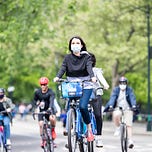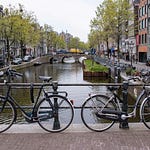Today I have a great start to the week for you: an interview with Laura Fox, general manager of Citi Bike at Lyft. Citi Bike, for those who don’t know, is the New York City bike-share program and the largest bike-share scheme in the U.S. Lyft took over Citi Bike and several other large urban bike-share programs in 2018 when it acquired the previous operator, Motivate, for a reported $250 million.
Laura and I covered everything from the history of North American bike-share to the stations the most bikes drain from when people go out to drink in New York. This newsletter/podcast also contains a **pro tip** for Citi Bike riders that I’m trusting you, the readers of Oversharing, not to exploit and to use in good faith. As Laura says, “Be a bike angel, not a bike devil.”
Interviews with smart people like Laura who are experts in their field are available exclusively to paid Oversharing subscribers. If that’s you, thanks for supporting this newsletter! If not, consider upgrading your subscription! You can listen to the audio or read the transcript, which has been condensed, edited, and embellished with links for context and clarity.
Oversharing: A lot of people might not know that Lyft owns Citi Bike because it was around for plenty of time before Lyft bought it. Could you tell people a bit about how that handover happened?
Fox: I think it could be helpful to start even before Lyft comes into the picture, a little bit of the history of bike-share in North America, which is interesting just from, how do you scale transportation systems, from an M&A perspective, and also cements why cities and private operators have been core partners in this kind of endeavor from the beginning.
So parts of the North America story start in 2009 in Montreal, actually with their parking authority, the MPA. And they decided that they wanted to bring bike-share to Montreal and to model it off of the Vélib’ system in Paris. And they called the program Bixi and then hired a local operator called 8D to do the software side of the work, who’d been kind of providing software for their parking operations and things like that. This combination of the city deciding to do this work, bringing in a software operator, and then the city doing the hardware side became some of the foundation for some of the programs that we have in North American and that have scaled globally. And the hardware side of the business ended up getting spun out a little bit later and was called the Public Bike System Company or PBSC.
When you say hardware side, we’re talking bikes right?
Bikes and stations also. When we fast forward a couple years to New York City and the launch of Citi Bike, Citi Bike was founded at the urging of New York City DOT. So again, public sector playing a major role in imagining a new transportation system being brought to New York City. The commissioner, Janette Sadik-Khan, after a visit to London, rode Boris Bikes—obviously now Santander—and was like, this is an incredible system, we need it for New York. And so came back to New York City, set up an RFP, found a private operator, and was even instrumental to thinking through the early sponsorship agreements to get the system off the ground.
At the time, the original operators for Citi Bike also contracted with PBSC to bring this station-based bike-share network to New York City. And oftentimes when we talk about Citi Bike, I think the thing that surprises a lot of people when you look at anything that’s really successful today is that there were struggles in the beginning, and there was certainly a lot of bumps in the road when you think about the launch of Citi Bike. Citi Bike was meant to be launched in 2012 and had all of the bikes and stations stored along the Brooklyn waterfront. And then Hurricane Sandy came in and flooded all of the equipment.
Yikes.
Yeah, big yikes. So, you know, needed to both repurchase all of that capital equipment, have to do a bunch of rework to then come back and launch in the spring of 2013. And then there were some early launch problems in the first year or so. And so the original operator was bought out and restructured into what became Motivate. Headquarters were moved to New York City. They began partnering with 8D, the original software provider to Bixi, to really think about bringing together this hardware-software stack to make bike-sharing a really reliable, great product within the city.
Motivate, for people who don’t know, was a major bike-share operator in North America that ran a lot of the biggest city—not Citi Bike, as in New York—but city bike-share programs.
Yeah. That includes Boston, DC, New York, Chicago, Columbus, Minneapolis, San Francisco. And then Lyft announced in summer 2018, the intention to acquire Motivate, and then because of that became basically the country’s largest micromobility player, in a lot of ways, overnight. At the time of the acquisition, I think all of those systems made up about 80% of the U.S. market. So Lyft also then took over some of these long term public-private partnerships that Motivate had built up over time and that are integral to the scaling of large-scale micromobility systems across the U.S.
So this became part of the group within Lyft that we now today called the transit, bikes, and scooters group. The first piece of work for that was really integrating all of these biking options and other options into the Lyft app. And one of the things that I find to be most striking is since the time of that integration, which was mid-2019 until today, we’ve had 2.5 million formerly ride-share only riders try out a bike and scooter for the first time, build habit, and become regular riders.
That rider stat that you provided, is that just for New York, or is that for all of the markets that Lyft acquired?
That’s for all of the markets. I don’t actually know since the beginning of the acquisition and integration time period for New York alone. Last year, for example, a third of all of our new riders—and we had about 850,000 new riders try Citi Bike for the first time last year—a third of those were ride-share only. So we continue to bring people over to try a bike and try a scooter for first time and think of it as a part of their transportation story. At this point, we at Lyft have about 15 markets that we own and operate ourselves. And then we recently bought—bringing it back, I guess to the beginning of the story—PBSC. So the whole OG bike-share community is back together, and they have a presence in about 45 cities globally and so combined that makes it about 60 markets. It excites us because we’ve always invested a lot on the hardware, software side of the house. Because all of our contracts are longer term, and so we need products to work over a long period of time. We need an efficient operating base and all of that. And PBSC brings a similar set of expertise together as well. And so really excited about what that combined expertise can do over time.
What brought you to Lyft? You were previously several different places, including Sidewalk Labs, right?
Immediately before this role I was at Sidewalk Labs, and joined around the time that the Toronto project had started, and ended up leading the development of the master innovation development plan that we had done for Toronto. I worked on everything from mobility systems and innovations, housing measures—probably my core comfort zone, I would say, or core area of expertise within kind of the urbanist world—but also worked on a bunch of things like building energy management and grid changes, to new way systems, public space innovation, new building materials from foundational elements. I really loved that period of time at Sidewalk. I call it getting a master’s in urbanism in a lot of ways, because we were thinking top to bottom, what is everyone doing? What’s working and really successful in some cities? How do we think about integrating that? What are the business models for getting that? There were a lot of really smart, talented folks who I hope will be friends and collaborators for life.
But what drew me to move to Lyft and Citi Bike was a chance to lead this next phase of Citi Bike growth, for a product and purpose that I love. When Lyft acquired Citi Bike, they made a commitment to expand and double the size of the Citi Bike service area over the coming five years to the tune about $100 million. That’s going to end up being a bit more than $100 million in size of investment. And really the scope is to go into parts of the city that had formally been underserved by transit, so oftentimes transit deserts, as well as densify the core of the network. For me, I’ve long biked to work daily. For many years it’s been hard to get me to shut up about the role of alternative mobility, like micromobility, and reducing things like congestion and urban emissions in cities, both of which I think that we need to do better and faster for the sake of our cities and for our planet.
Then on top of that, I originally grew up on the south side of the city, a historic transit desert. So our expansion into many New York City transit deserts is just really meaningful for me personally as part of the work that we’re doing on a daily basis. Because you can think about micromobility infrastructure as being a bit more nimble than some larger-form fixed transit. And so this has been a real dream role for me in a lot of ways.
Could you walk me through how a contract like a bike-share between Lyft, Citi Bike, and New York works? For instance, one criticism people who dislike bike-share will sometimes say is, ‘This is a waste of my tax dollars.’ But I think that’s a misunderstanding of how the contract works and who’s paying for what.
When we think about what makes a bike-share system successful, it does really require public sector and private sector to come together and to think about a long-term partnership and in a way that both the city and the operator are mutually invested in that long-term success. There’s a lot of different flavors of how contracts can come together. The one that we have in New York, for example, is one in which we as the private operator both invest in all of the hardware aspects of the system—so stations, bikes, etc.—and then also own all of the operational risk. And then in turn have a contract with the city.
And so, the city plays a really integral role in that. So while we don’t get, today, any public subsidies from the city, the city leads the partnership in some ways that I think are critical and instrumental to the success and growth of Citi Bike. A couple that are top of mind: one, station density. The network of Citi Bike is planned so that anyone is within a 5-minute walk of the nearest station. And that’s planned by the Department of Transportation, and obviously they own right of way, both on the roadbed side and on the sidewalk side, work with community boards to make sure that that network goes down. We work together on sighting.
And then a second piece that they do is, as part of that network design, really thinking about robust transit connections. When we survey Citi Bike riders, more than 90% of folks connect, take a bike to connect to public transit over the course of a year. 60% on a weekly basis have that same behavior, so riding a bike to a transit hub. And I would say that multimodal sustainable mobility trip behavior doesn’t happen by accident. It happens because purposefully, density was planned around transit hubs so that you could easily ride from a more residential neighborhood to that transit hub.
And then a third area, obviously, that the city really leads on is all of the public street infrastructure. So bike lanes. New York City has 600 miles of protected bike lanes, and Mayor Adams committed to building out nearly another $1 billion of bike lanes earlier this year.
Which translates into roughly how many miles?
We have a commitment of at least 30 miles per year over the next couple years. My hope too is on top of that commitment, the trillion dollars of the infrastructure bill that was passed in the U.S. allocates a lot of money to safe street campaigns, and that can be filtered down into cities. A lot of federal folks, including Senator Schumer, are really interested in how do we bring that into building out protected bike lane infrastructure in New York City. And New York has a plan, I think it’s by 2030 [ed. note: the goal is 2050], where the goal is to have 10% of trips occur via bike, and so 10% of roadway. And so obviously there’s a significant effort to do that. Hopefully the infrastructure bill can benefit sustainable modes of micromobility in a similar way.
Personally I always thought it would be great if New York picked an avenue and then a couple streets every 20 blocks and made them just for bikes. So all of 10th Ave could just be bikes and then you could have some cross streets and it would make it so easy to go up and down Manhattan, because the whole thing is gridded.
I think that could be a great solution. Things like what Barcelona is building in terms of superblocks serve some of that purpose too. We were thinking about a lot of this at Sidewalk too. You can have major streets, boulevards, or others acting as continued car, commercial, etc. And then you can think about other streets that have other purposes and superblocks have been designed with that in mind. Where you have streets that are specifically designed for walking, biking, more public use of space.
Yeah. Super interesting. And then you could divide between cyclists who are going fast and commuting, or cyclists who are going with families, or maybe slower. You could have a space for cargo bikes. What a dream, to have a whole avenue for bikes.
It would be a total dream. Rit Aggarwala, who’s now the chief climate officer for New York City—we had worked together at Sidewalk. He was at Cornell Tech last year and led a really interesting report on recommendations for the new administration and on the transportation side for those of us who he’d brought together as a brain trust and thinking through this. That exact thing that you just mentioned became one of the big areas of debate. Of how do you start to incentivize more modes of micromobility and light electric vehicles in general? And then how do you start thinking about a segmentation by speed, knowing that folks who are on pedal bikes and maybe lightly powered light electric vehicles are obviously going to be going a little bit slower than folks who are on fast-powered e-bikes to more of like a moped, larger form factor, but still quite small.
And what was the takeaway?
Everyone wanted it. But then it’s thinking through how do we continue to grow that network and at what phase does that make sense? But getting back to the public-private partnership for Citi Bikes, so those are some of the main things that the city does. And then on the private side, Lyft’s role in the partnership is generally related to areas that it makes sense for private business to own.
So, a couple areas. First, technology, which you can break into hardware and software. On the hardware side, we do bikes, stations, all sorts of components. Again, really want to make them a product that’s long lasting. And we still have bikes on the street from 10 years ago. We want to make sure that’s something when we build in long-term contract and stations from 10 years ago, we’re thinking about durability of the product itself. And second under technology is the software side. So both the things that you experience as a rider: how you navigate the system, fun things like how many stations you visited across the system and how you rank against other riders, rider Bike Angels programs, to the backend side of that platform, which is helping our operations team be routed really effectively in terms of battery swapping tasks or rebalancing tasks based on an algorithm, the repair side. So lots of areas there.
The second piece, top of mind, that we own is obviously the investment in capital dollars, operating dollars, that we talked about earlier in terms of this being one of our largest moments of expansion across history of the program. I’m remaining really excited about what this means for developing this alternative mobility transportation network, because by the end of this phase of expansion, we’ll cover an area that’s equivalent to something like 60% of New York City population and 70% of NYCHA housing [New York City Housing Authority]. And so can really provide high density of services across the city.
So just to make sure I’m understanding correctly, per the contract: New York City grants Lyft for 10 years the exclusive right to operate bike-share in New York City. The city doesn’t give Lyft any money, but they give them that permission to be the only bike-share operator for that duration of time. And then Lyft puts in the tech and the capital and manages the operations. And then when people rent a Citi Bike, that money goes to Lyft.
Yep, that’s right. And a lot of that money goes to funding major expansions of the program.
As in Lyft, reinvests that money into the program.
Yeah.
Does Lyft have to pay the city anything in terms of the operating permit? For example, how a lot of scooter companies have to pay permits and licensing fees—is that also true of bike-share?
Every city is a slightly different flavor on that side. We pay things like a lost parking meter revenue dollar value per year. If you’re a city, you want to protect yourself and make sure an operator is doing a great job. And so there’s service-level agreements that are part of that. If there’s any miss in a service-level agreement, then we pay that fine, for example. But less like some of the scooter side of the business.
There are other markets that operate in different ways. For Capital Bikeshare, for example, D.C. both invests in and owns the equipment and then pays an operating fee. So they completely own the system and can fully control everything from expansion of new stations—and Mayor Bowser just committed a sizeable investment there—to how they want to price things, to different incentives that they want to run, and all of that. Boston has another flavor of the model, which is the city of Boston invests in the infrastructure. So all of the equipment—stations, bikes, etc.—but then doesn’t pay an operating fee. And so we keep the revenue and make the operations work as part of that. And again, Mayor Wu obviously is huge cultural moment in the U.S. right now, in terms of all the cool transportation stuff that she’s doing, is also expanding parts of the Bluebikes system as part of that.
So to use any of these programs now, or specifically Citi Bike: is it all managed from the Lyft app, or is Citi Bike, for instance, integrated with the OMNY tap-to-pay that’s been rolled out across the New York subway?
It’s not yet integrated in that, although I have a dream where you could rent a Citi Bike and get like a free transfer to the subway or something like that. I think the whole tap-to-pay system that the subway has put in and the way that they’ve thought through that is really interesting and has a lot of great opportunities for what that could look like in terms of expansion over time. Right now you can take out a Citi Bike through the Lyft app and then you can also ride through the dedicated Citi Bike app itself.
It’s funny how you’d hope public transport payment in general would be really simple, but it’s so complicated. Every system has its own fare and card. You fly to any country and you can use your credit card to buy things in the store there, but you go to a new public transit system and it’s like, oh, I’ve got to get the card and then I have to load the dollars and do I want a day pass or do I want a 12-hour pass or which zone am I going to? I don’t know, because I’ve never been here. Am I peak or off peak? It would be helpful if they posted that somewhere, because I’m really not sure.
Yeah. On a recent trip to London, the digital payment system made all of that so much easier for me, because usually I would be at the kiosk, what zone am I going to, oh wait, I don’t know. And then just with the tap-to-pay it makes it automatic in a lot of ways. I think the worst city from that perspective I’ve ever been to is probably Bangkok. I think Europe has done a really nice job in many European countries owning the rails and then having private-sector operators run some of those rails. And then they pay typically operations fees and things like that, but the public entity will own the end-to-end of both the infrastructure as well as the product.
So they’re able to do lots of cool things. I think it was Switzerland recently, they came out with a single unified payment method across all modes and then made everything free if you weren’t taking your car. Versus a city like Bangkok basically privatized all of the rail units and so to get into the center of Bangkok, you typically have to transfer two to three times and then you have to pay two to three different fees to two to three different operators to make that work.
So unnecessarily complicated! Another thing I wanted to ask you about is rebalancing. My understanding was that rebalancing was sort of the core challenge in any shared micromobility system—feel free to disagree with that—but regardless, what do you think the hardest thing is and how do you deal with rebalancing?
I gave a talk just last week or the week before where I tried to convince audiences that maintenance and operations are sexy.
How did that go?
It’s my perception. But it’s necessary for getting the outcome that you want. And some of these big systems, both from what the rider experience is like on a day-to-day basis and a micromobility system to—when we talk about climate tech, for example—it’s maintenance and operations that are essential to seeing actual GHG reductions. And so I think maintenance and operations, ‘most sexy’ in quotes, but also some of the hardest.
My first day of this job, 3.5 years ago, my then manager told me the hardest problem in bike-share is rebalancing because we’ve done so much work on this over time, but the core challenge is meeting supply and demand in hyper dense cities with large physical objects that need to be moved around that city. We’ve invested a lot in both the underlying algorithm, so rather than just observing what the system looks like now and what we want it to look like in the future, we look at how can we predict what the system is going to need and how can we deliver against that prediction based on data collected over the course of three weeks? And how can we deliver supply against demand that we know is coming up two hours from now or three hours from now.
Just to interject, for people who don’t know, rebalancing means moving the bikes to where they need to be.
Yeah. The scope of the problem is we have 28,000 bikes in New York, and to match that you’re in one neighborhood and want to ride to a future neighborhood, maybe you don’t ride home. And so the system doesn’t naturally always self-balance.
What are some routes you’ve identified as reliably: everyone takes bikes from here to here, and we know we have to bring them back.
So the Upper West Side of New York, bikes drain. Everyone loves to bike out of the neighborhood, but don’t like to bike back. For a while we thought it was because there wasn’t a great, outside of Riverside Park, uptown bike path, but now there’s one right along Central Park and we’re still not seeing bikes go back. We’ve done lots of user research on the topic and I think there’s a perception that you’re going uphill.
That to go uptown is to go uphill? That’s amazing.
This makes sense because my brother lives on the Upper East Side, and he figured out years ago that a really lucrative Bike Angels project for him was every morning to take a bike from the UES, around Central Park, drop it off on the UWS, and then walk back through the park. He had a lot of vouchers from that.
Which is the critical part. There’s other neighborhoods that pool bikes, like Red Hook and Williamsburg, people go to have a drink, have some key lime pie, see some music or Pioneer Works, and then they’ll take the bus or a ride home. But there’s a lot of going somewhere that is more of a later evening destination. So bikes tend to accumulate. What I love about your brother’s story is that’s the reason why we built the Bike Angels program.
Did Lyft build that? I thought it predated.
Yeah, it predated. It started in 2017 or so. We knew that people could be nudged to become what we call casual angels. So, I’m riding home and there’s a station near me or two stations away that I could get three points for, and I would get zero points going to my current station. Would someone walk an extra 5 minutes to accumulate some points?
That seemed like an obvious thing at the time. What didn’t seem obvious, but has been really important to the overall rideability health of the program, is what we call power angels, which are maybe 10% of total Bike Angels and really do a lot of what your brother was doing. Which is like, take some of those longer trips, or actively doing multiple trips in a row. I’ve talked to people who use it as part of their training routine. So they’re like, ‘Okay, I know that if I drop a bike off in one area and then I run half a mile in another direction, I can basically keep doing that and accumulate a great number of points over the course of a morning get an interval training workout.’
Bike Angels overall are what percent of actual rebalancing needs for the entire program?
It’s about a third. Some of them are intentional and some of them are less intentional.
That’s much higher than I thought it was going to be!
And we do a lot of things to make that a great community and program. I think there’s a natural community to it too, because there’s both the very tangible benefits that you get, which is you get membership extensions, free e-bike minutes, and things like that, so you can basically ride for free based on the number of points you get. And then above a certain level, you also start getting more gift cards and paid in cash, but then there’s also lots of cool swag as part of being a member of the bike-share program, which your brother probably has.
I do this set of mobility happy hours in New York, and people will sit down and look at their keychain and say like, ‘Oh, are you a bike angel?’, and talk about their favorite routes, and why they do it, and what makes it meaningful for them. I think there’s a side of this which is the tangible of benefits, but also bike-share is about sharing, and how can you create a system that works for the next rider, not just for yourself.
On the sexy topic of maintenance—
Are there other topics there?
Exactly. I mean, it’s the only one really. So then the two-thirds of rebalancing that Lyft deals with operationally, what are the strategies that you’ve developed around that?
We have two other big key levers. One is what we call bike valets. They operate in the same way that maybe other types of valets work. Basically, if someone is going into a crowded, high-density part of the city, like a FiDi or a Midtown, that tends to create a lot of demand at the beginning of the day and then similar demand at the end of the day. So you have balanced, very high demand. We have stations that are over 100 docks in some of those areas, but demand will still exceed the capacity that we have built in the network. And so valet is basically, as you go and dock a bike, we’ll take that bike and start stacking it. So we create an efficient system. It physically looks like bikes will go up against three different docks essentially. Then we stack them in an alternating, handlebar on one side, handlebar on another, to create an efficiency of space. That’s a great strategy for if you have equal demand at the beginning of the day and the end of the day.
You’re just dealing with storage in the middle of the day. And then the second other lever that you have to pull on is?
Those are, again, in instances where Bike Angels are oftentimes helpful as well, which is where the demand is different at different times. So a valet won’t work. In an area like the Upper West Side, if you put in a valet and all the bikes leave in the morning and very few of them return, there’s nothing to stack. And so the other mechanism that we use are larger rebalancing vans that are doing some of the longer routes, taking bikes from Red Hook and bringing them up to Long Island City or Astoria or something like that. Or from downtown Manhattan up to the Bronx. They’re doing some of those longer routes traditionally, where we have high system and balance but need to make a longer trip, which would be really hard for someone who’s looking to earn points. Like, I love your brother running across the park, but would he bike from FiDi to the Bronx? Probably not. Each parts of that equation are meant to help solve this problem and then facilitate the next set of rides.
There’s obviously a seasonality to any micromobility business. I was looking at the reports that Citi Bike files and you put out more bikes in the summer, which makes sense because it’s nice and people want to ride around. Where do these bikes live in the winter?
We store some bikes in the winter off the street for, as you can imagine, big, snowy, salt-filled winter cities like New York, to just keep them off the ground for a period of time. We have some warehouse space for those. The piece that I’ve always found really interesting about weather though is how correlated is ride behavior to weather. My first winter I was fascinated by this idea. I’ve always been an all-season biker, but I have a lot of friends who, you know, if it’s a nice sunny day, they’ll ride, and it’s not too hot. And what does that look like in our own data?
If you look at it, there’s very low correlation between weather and our members. So members are folks who are riding, 70 times, 100 times, 200 times per year. I think the last couple years have been really interesting in that for the most part people who have been riding have been much more locals than tourists given the pandemic. So we did have 1.3 million unique riders last year, and the vast majority of those were locals. As an aside, whenever people tell me, ‘New York could never be a Copenhagen or an Amsterdam or get as many people riding,’ I’m like, Citi Bike alone had 1.3 million, mostly New Yorkers, riding last year!
You guys have had a series of record months recently, haven’t you?
Yep. Last year was a record year. To anchor us in some of the numbers: we had nearly 28 million rides, increased about 40% over the prior year. The prior year was 2020, about net to 2019. And so unlike other modes of transit, we saw an initial dip during the pandemic but then ridership start to grow. For this year, we just had 3.7 million rides in August, a record-breaking month. I was really hoping for a 4 million-ride month in September, but we had a lot of rain in New York, so great for the thirsty plants. But we broke our single-day record three times in one week in September too: nearly 140,000 rides in a single day. So have really seen Citi Bike growing in terms of population, rider and user base, types of use cases. Even though commuting use cases have gone down, for example, we’ve seen a lot of leisure use cases increase. A stat that I always find really interesting is that our ridership at 9pm right now is oftentimes greater than our ridership at 9am, which in a pre-pandemic world never would’ve been the case.
Of the trips that were happening pre-pandemic in the am commute hours, that’s dropped about 25% as a percentage of total trips across a day. And that’s gone to mid-afternoon, to later evening, and other use cases, which has been interesting to see. Hopefully when we think about the national household transportation data, if today 50% of trips in cities are below 3 miles, I’m expecting the next time that gets done to be much larger than 50% being under 3 miles. Because with hybrid work, people will probably be doing more errands closer to home, and so I think that creates an even greater opportunity for micromobility and then longer leisure trips as you start to get comfortable there.
I could talk to you about this stuff for ages, but to wrap it up, I wanted to ask you a philosophical question. Obviously you work at Lyft, and Lyft owns Motivate, which as we’ve talked about is a public-private partnership. I wonder what you think about the question of whether ultimately services like bike-share are better off run as public-private partnerships or should be another part of public transit that falls under whatever the city agency is. For New York it would be the MTA, for London bike-share actually is under TfL. How do you think about that, as someone who is in the private world, but also has worked in urbanism and things like that?
Yeah, and worked in the public sector side earlier in my career too. I don’t think that today there’s a total binary in a lot of ways. So I think the idea of is it public or is it private is a little bit of a trick question. Like we were talking about earlier, there’s so many different flavors of a public-private partnership, and bike-share systems today sit in probably a pretty gray space, with some leaning more towards fully private. So when I think of fully private, that’s probably something more like what’s true in many scooter markets in terms of having permit models and things like that. And then others that lean more public, like what we were talking about for D.C. and capital bike-share.
I think that what I’ve seen with Citi Bike is that the mix of those skill sets that we were talking about earlier—of what can the public sector bring and be really great at, and what can the private sector bring and be really great at—has over time created a really nice balance of public sector doing what they’re best at. Network planning, network design, really working with community boards, right away, thinking critically about infrastructure. And then private sector doing what private sector is good at. Some of the technology. Some of the investment side, operations and really driving efficiencies, some of the community and equity work that we do. I think that there is, within that gray area, a nice collaboration that exists today. TFL is a really interesting model within London where they are able to bring in some of those elements of public and private because they have private sector operators there too. I think that it could probably vary based on context, based on local budgets, based on amount of control a city wants to have or can have as they think about integrating across a number of modes.
And equity concerns also.
And equity concerns. For Citi bike, we have the largest equity program in the country. About 10% of all of our rides this year are done by our reduced fare bike-share members. So, folks living in NYCHA housing or with SNAP benefits and others. That gets even higher when you look at e-bike usage. About 13% of all e-bike rides are done by equity members. We’ve also really invested in making sure that other equity elements as part of the program—so 61% of riders last year identified as part of a racial or ethnic minority group, and we’ve seen a lot of success over the years trying to improve some of those numbers. I think a next phase of something like this could be thinking about what if a system like Citi Bike were included in the Fair Fares program, or things like that, where there’s contributions of public sector to equity in really interesting ways.
The very last thing I wanted to ask you, as a treat for people who made it to the end of this interview is: I got a tip that you can get a free ride on an e-bike in Citi Bike if when you go to the station there are no pedal bikes present at the station. Is this true?
That is true. Because it’s something like, we’re committed to providing for members. If you want to take a classic ride, but that’s not available to you, there should be no marginal cost to the rider. I would say that comes with pros and cons, in that we want to be really great to riders with providing that as a benefit, and then we see people who are bad actors to the system, who will go and wrench a number of classic bikes at a station to get that e-bike. And that’s behavior that we’re starting to investigate further and start to crack down on.
That seems like a lot of work to get a free e-bike.
Yeah, it’s a lot of work, but people are doing it.
All right. Well that’s an Easter egg for anyone who got to the end of this.
But don’t be a bad actor. And remember that bike-share is about sharing, not about taking 10 bikes out of the fleet for the next rider.
Be a good faith user of this pro tip.
Right. Be a bike angel, not a bike devil, or however we want to term it.
That should be the slogan for this podcast. Be a bike angel, not a bike devil.











Share this post